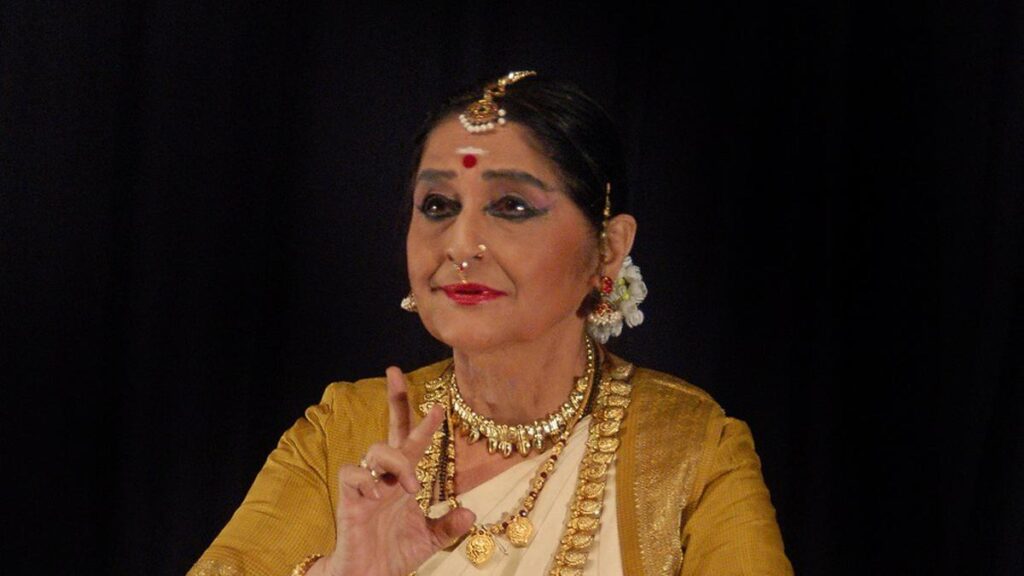Kanak Rele’s name is synonymous with the exquisite dance form of Mohiniyattam.
I am constrained to write this with a sense of guilt. I would have done this on February 22, the first death anniversary of Padmabhushan Dr Kanak Rele whose contributions for the revival and propagation of Mohiniyattam are monumental.
She strode like a colossus for more than four decades totally dedicating herself for the lasya-rich dance form of Kerala origin, though she was not a Malayali. Further, no other Mohiniyattam dancer has garnered encomiums like her, perhaps the highest being the first recipient of Guru Gopinath National Puraskaram instituted by the government of Kerala. Again, all the recognitions and titles for a Mohiniyattam dancer first went to her always: Sangeet Natak Akademi award, Kalidas Samman, Padmashree and also Padmabhushan, to mention only a few.
Kanak Rele’s achievements are a testimony to Martha Graham’s saying, “Great dancers are great not because of their technique, but because of their passion”.
The passion for dance was so intense that a brilliant student like her refused to join the MBBS course even after she was selected and had paid the fee. Her choice was study of Industrial Law for which she joined the Government Law College. Commendable was the performance in the examination and she was selected for the study of International Law at the Manchester University, UK, for post-graduation. Interestingly, her specialization was Civil Aviation which landed her a coveted post in Air India, after successful completion of the course.
But again it was her passion to pursue Kathakali and Mohiniyattam, to which she was exposed at Santiniketan as a child that compelled her to forgo that offer against the wishes of her parents. But unstinted support from her husband during those trying times and guidance of the Guru Karunakara Panicker (Kathakali) were factors that enabled her to pursue her own choice with single-minded devotion.
Recognising the lasya elements
Presence of Kalamandalam Rajalakshmi in Mumbai those days was helpful in introducing her to Mohiniyattam. The basic lessons as practiced in Kalamandalam that had revived the dance form during the 1930s could be learned from her. The exquisite charm of lasya attracted her and she was determined to delve deep into the roots of the dance form which had its first revival during the period of Swatithirunal and had vanished from arc lights thanks to a variety of reasons.
A study grant from Sangeet Natak Akademi at this juncture was a blessing as it enabled her to meet the surviving performers and scholars who could enlighten her about the evolutionary stages of Mohiniyattam. Her pursuit received further impetus thanks to a grant from the Ford Foundation. She met the surviving exponents like Kalpurathe Kunjukutty Amma, Thottassery Chinnammu Amma and Kalamandalam Kalyanikutty Amma and filmed them. Incidentally, the recording is a prized possession in the archives of her institution in Mumbai even now.
Kanak was successful in recreating the dance form based on the traditional and technical format which she could ferret out from the film and further in evolving a teaching methodology too. Intensive research on the kinetics of the dancer, based on the movements of Volution (geometrical patterns) and Revolution (spiral) so characteristic of Indian classical dances and an analysis of the audio and film documentations against the backdrop of Natyasastra, Hasthalakshanadeepika and Balarama Bharatam gave shape to the ‘Kanak Rele School’ of Mohiniyattam. The ‘Kine-aesthetics’ was propounded taking advice from experts belonging to all disciplines including medical science. The monumental work further fetched her PhD from the University of Mumbai.
Revival, propagation and scholarly exploration
While she had dwelt at length on the prayoga of the dance form in the first edition of the book ‘Mohiniyattam- The Lyrical Dance’ (1992), she has been successful in building up a sastra in the revised edition (2013) which is logically and aesthetically perfect. The other work ‘Bhava Niroopana’ (1996) is a comprehensive account of the theoretical basis of abhinaya and it further traces the development of our religious thought and its influence on aesthetics. Small wonder, the two books are followed in institutions all over the country including Kerala Kalamandalam Deemed to be University for the undergraduate and postgraduate classes.
While Nalanda Dance Research Centre (1967) was founded in 1967 for research, Nalanda Nritya Kala Mahavidyalaya was established in 1972 for the popularization of her style. Thanks to her persevering efforts the institution was affiliated to the University of Bombay. Admittedly, the institution was the first in the country to award university degrees of BFA, MFA and PhD in Mohiniyattam.
The foray into Sopana Sangeetham happened after meeting Kavalam Narayana Panicker in 1982. This was providential for she could overcome many rough edges with sudden jerkiness experienced while following the music and talas of Carnatic system. Innumerable have been the workshops she had with him in Mumbai. Even during her visit to him four days before his demise, the duo had discussed plans to organise more workshops
A prolific choreographer, she has to her credit 51 productions on varied themes and 13 on the legendary women of the puranas. Small wonder, she was conferred with the title ‘Kulapati of Mohiniyattam’ by the institution Kalakshetra, Adayar.
On numerous occasions she had invited me to Nalanda for seminars, previews and festivals. She would advise me to reach Nalanada a couple of days earlier for discussions. We met for the last time in May, 2022 in connection with the release of her autobiography, ‘Me and My Mohiniyattam’. The glamour girl of Bollywood Hema Malini and I were special guests. Her warm hospitality and concern for me will remain etched in my mind for ever.

